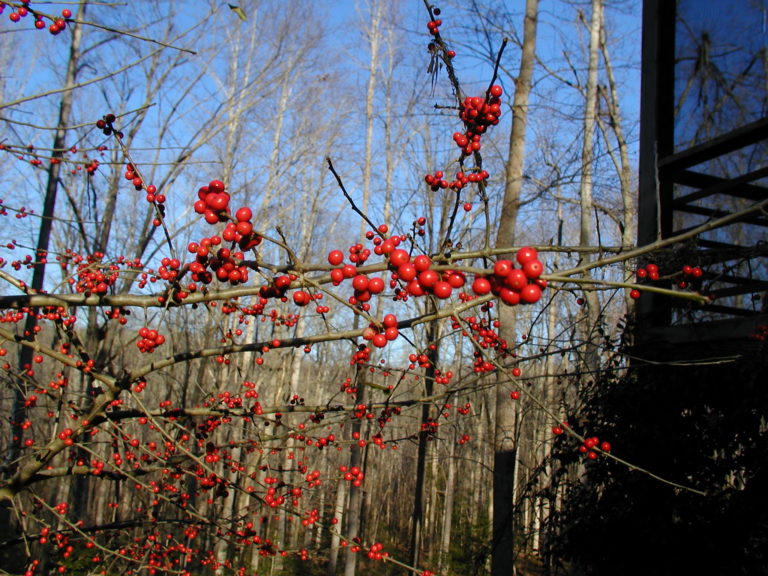Possomhaw Holly is a deciduous shrub or small, understory tree, averaging fifteen to thirty feet tall (shorter when grown in full sun), with gray, twiggy, horizontal branches. In nature, it occurs in dry woods but more often in river bottoms and wet habitats, from Maryland south to Florida and west to Texas, Oklahoma and even Kansas. The mature tree has a rounded crown and marked, 90-degree branch angles. Possumhaw has attractive glossy, oval, serrated dark green leaves which persist until late autumn, when they rapidly decline and fall. Like all Ilexes, the flowers of Possumhaw are not conspicuous, but grown in adequate sun, it can be a stunning specimen in the autumn and winter when the bare branches are covered with numerous bright red, ripe berries. It is a dioecious species, so a prominent female specimen can be pollinated by a conveniently nearby male of the same species, or even by a nearby American Holly (Ilex opaca). Happily, this tree is not only beautiful, it also serves as an important nectar source for all manner of bees and other pollinators, and as winter food source for song birds. Opossums, raccoons and other mammals also greatly desire the fruit, should they be lurking in the vicinity.
NURSERY HOURS
Wednesday: 10-4 Thursday: 10-6 Friday-Saturday: 10-4 Sunday: 12-4
Ilex decidua

Key Info
Scientific Name: Ilex decidua Walter
Common Names: Possumhaw Holly, Deciduous Holly, Meadow Holly, Prairie Holly, Swamp Holly, Welk Holly, Deciduous Yaupon, Bearberry, Winterberry
Family Names: Aquifoliaceae (Holly Family)
Plant Type: Tree / Shrub
Leaf Retention: Deciduous
Bloom Times: May
Flower Color: White
Special Characteristics: Showy fruit (females), Attracts bees, Attracts birds, Tolerates wet conditions
Additional Info
Habit: Upright multi-stemmed shrub or small tree with a spreading, rounded crown, pale grey bark, branch angles 90 degrees, horizontal branches, tap root.
Height: 12'-30'
Spread: 12'
Soil Conditions: Wet, moist, dry; prefers moist, organic, well drained, acidic; sandy, sandy loam, medium loam, clay loam, clay.
Leaves: Simple, oval, glossy leaves 2-3 inches long with rounded teeth remain dark green until late fall, when they turn yellow and drop.
Flowers (or reproductive structures: Dioecious (male and femle flowers on separate plants); flowers small, 4-petaled, white, not showy, females with prominent, green pistils, males with prominent stamens.
Fruit: Berries ripen from green to red in September/October and persist through winter on female plants until they are devoured by birds.
Natural Distribution: Woods, wet woods, river bottoms
USDA Hardiness Zone: 5 to 9
USDA Wetland Indicator Status in NC: FACW
Pollination: Bees, butterflies, other insects
Wildlife Connections: The tree provides cover and supports nesting of many birds; flowers attract nectar-loving insects; the berries are an important source of nutrition for songbirds and gamebirds, opossums, raccoons and other mammals.
Propagation: From seeds.
